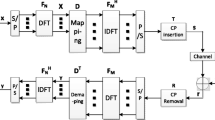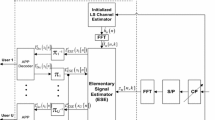Abstract
Orthogonal frequency division multiplexing (OFDM) based wireless communication systems are expected to satisfy the thirst for ever increasing demand on higher spectral efficiency. But, OFDM systems suffer from peak to average power ratio (PAPR) and inter carrier interference (ICI) problems. It is observed that when OFDM is used in the uplink, PAPR problem is more severe and the relative mobility of the user equipments with respect to the base station will cause Doppler spread which leads to ICI. One of the solutions to minimize PAPR and ICI is single carrier frequency division multiple access. But there is a tradeoff in spectral efficiency. The main objective of this paper is to evaluate the performance of fractionally spaced equalizer (FSE) for blind channel estimation based on higher order statistics and to identify any better alternative to improve its performance. Dynamically varying modulus algorithm (DVMA) based FSE is proposed in this paper which is a better alternative for supervised equalization. The simulation results prove that FSE blind equalizer based on DVMA outperform the conventional supervised and blind equalizers.



















Similar content being viewed by others
Abbreviations
- GSM TDMA:
-
Global system for mobile communication time division multiple access
- WCDMA:
-
Wideband code division multiple access
- LTE:
-
Long term evolution
- LTE-A:
-
Long term evolution-advanced
- Wi-MAX:
-
Worldwide interoperability for microwave access
- ISI:
-
Inter symbol interference
- DL:
-
Downlink
- CP:
-
Cyclic prefix
- AMC:
-
Adaptive modulation and coding
- MIMO:
-
Multi input and multi output
- QAM:
-
Quadrature amplitude modulation
- LS:
-
Least square
- MMSE:
-
Minimum mean square error
- RLS:
-
Recursive least square
- LMS:
-
Least mean square
- NLMS:
-
Normalized least mean square
- SER:
-
Symbol error rate
- CFO:
-
Carrier frequency offset
- AWGN:
-
Additive white gaussian noise
References
van Nee, R., & Prasad, R. (2000). OFDM for wireless multimedia communications. London: Artech House Publishers.
Sesia, S., Toufik, I., & Baker, M. (2009). LTE—The UMTS long term evolution from theory to practice. West Sussex, UK: Wiley.
Cho, Y. S., Kim, J., Yang, W. Y., & Kang, C. G. (2010). MIMO-OFDM wireless communications with matlab. Singapore: Wiley.
Myung, H. G., Lim, J., & Goodman, D. J. (2007). Single carrier FDMA for uplink wireless transmission IEEE. Vehicular Technology Magazine, 1(3), 9–17.
Masud Rana, Md., Kim, J., Cho, W. K. (2010). Training based channel estimation scheme for LTE SC-FDMA Systems Using LMS algorithm. Proceedings of International Conference on ICCEE.
Lau, H. K., & Cheung, S. W. (1994). A pilot symbol-aided technique used for digital signals in multipath environments. IEEE ICC, 2, 1126–1130.
Temino, L.A.M.R.D., Manchon, C.N.I., Rom, C., Sorensen, T.B., Mogensen, P. (2008). Iterative channel estimation with robust wiener filtering in LTE downlink. Proceedings of International Conference on VTC, 1–5.
Dimitris, G., & Manolakis, D. G. (2000). Statistical and adaptive signal processing. London: Artech House.
Haykin, S. (1996). Adaptive filter theory. Upper Saddle River, NJ: Prentice-Hall.
Yameogo, S., Palicot, J., Cariou, L. (2009).Blind time domain equalization of SC-FDMA signal. Proc. Vehicular Technology Conference, 1–4.
Zeng, W. J., Li, X., Cheng, E. (2011).Blind and semi blind channel estimation for single carrier block transmission systems using few received blocks. IEEE International Conference on Communications (ICC), 1–5.
Lyman, R.J., Edmonson,W.W.(1999). Decision-directed tracking of fading channels using linear prediction of the fading envelope. 33rd Asilomar Conference on Signal Processing, Systems, and Computers, 2, 1154–1158.
Ran, J. J., Grunbeid, R., Rohling, H., et al. (2003). Decision-directed channel estimation method for OFDM systems with high velocities. IEEE VTC, 4, 2358–2361.
Xinmin, D., Haimovich, A. M., & Garcia-Frias, J. (2003). Decision-directed iterative channel estimation for MIMO systems. IEEE ICC, 4, 2326–2329.
Daofeng, X. Luxi, Y. (2004). Channel estimation for OFDM systems using superimposed training. International Conference in Central Asia on Internet, 26–29.
Hoeher, P., Tufvesson, F. (1999). Channel estimation with superimposed pilot sequence. IEEEGLOBECOM, 2162–2166.
Godard, D. N. (1980). Self-recovering equalization and carrier tracking in two-dimensional data communication systems. IEEE Transactions on Communications, 28(11), 1867–1875.
Sato, Y. (1975). A method of self-recovering equalization for multilevel amplitude-modulation systems. IEEE Transactions on Communications, 23(6), 679–682.
Johnson, R., Schniter, P., Endres J. T., et al. (1998). Blind equalization using the constant modulus criterion: A Review, IEEE, 86, 1927–1950.
Rana, M. M., & Kim, J. (2011). LMS based blind channel estimation of SC-FDMA systems using variable step size and phase information. Electronics Letters, 47(5), 346–348.
Mountassir, j., Nafornita, M. (2012). A blind channel estimation Technique based on denoising for LTE downlink and uplink system. Transactions on Electronics and Communications, 57(71).
Bolcskei, H., Heath, R. W., Paulraj, A. J., et al. (2002). Blind channel identification and equalization in OFDM based multi antenna systems. IEEE Transactions on Signal Processing, 50(1), 96–109.
Jiang, Du, Peng, Qicong, & Zhang, Hongying. (2003). Adaptive blind channel identification and equalization for MIMO wireless communication systems. Pearson, Indoor and Mobile Radio Communications, 3, 2078–2082.
Author information
Authors and Affiliations
Corresponding author
Rights and permissions
About this article
Cite this article
Vinoth Babu, K., Ramachandra Reddy, G. & Arun Prakash, J. Fractionally spaced equalizer based on dynamically varying modulus algorithm for spectrally efficient channel compensation in SC-FDMA based systems. Wireless Netw 20, 1387–1398 (2014). https://doi.org/10.1007/s11276-013-0678-6
Published:
Issue Date:
DOI: https://doi.org/10.1007/s11276-013-0678-6




